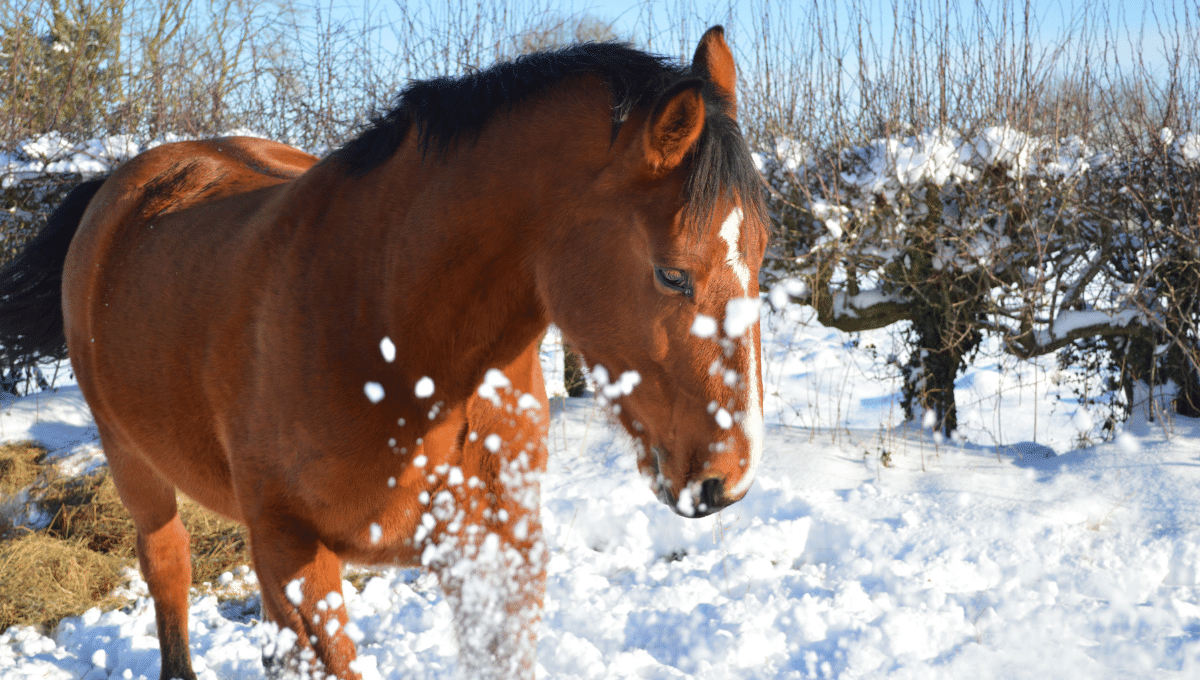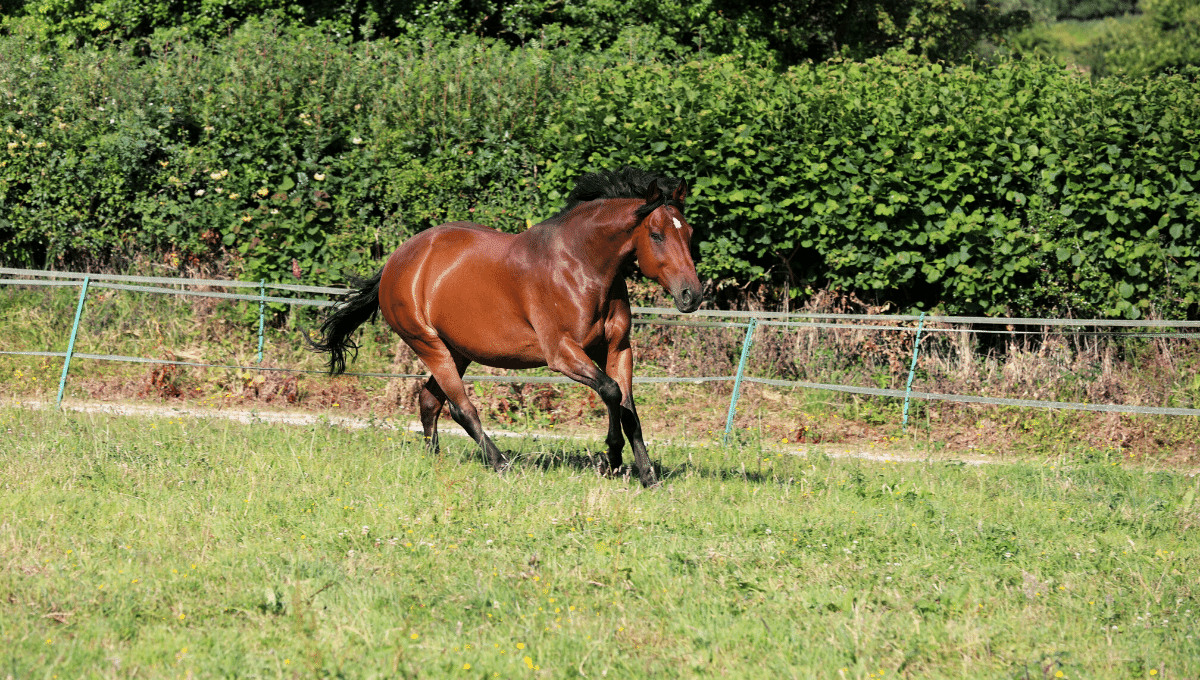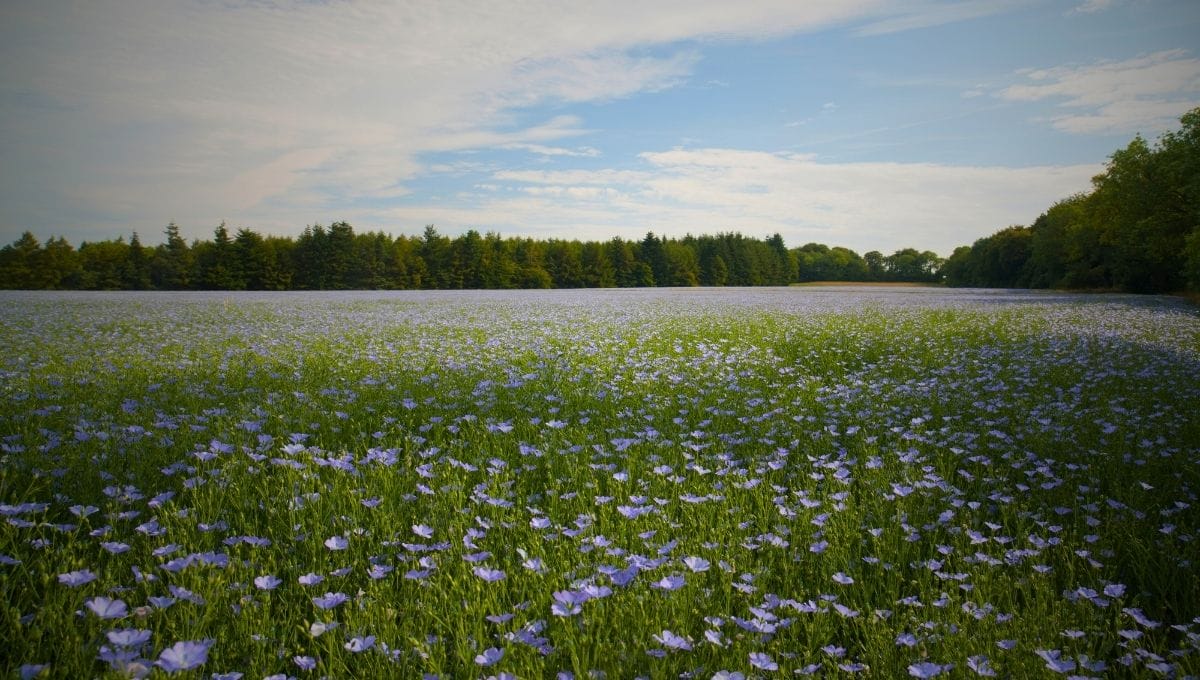As horse owners, it is crucial to ensure that our horses receive the necessary nutrition to maintain their health and well-being over the colder winter months.
In this blog post, we will discuss 10 ways to know what nutrition your horse needs during for the winter months. We will also share some valuable winter horse feeding tips, covering everything from dietary adjustments to key considerations. Our structured guide will provide top tips for winter, focusing on nutrient needs and feeding strategies to help you maintain your equine companions during the colder months
Calories are often the easy part of feeding horses, especially with good doers, but how do you know what nutrients and at what level they are needed in the daily diet to protect the health of skin, hooves, and maintain optimum winter horse health?
There are many horse supplements on the market but choosing the right one to give your horse the protein, minerals and vitamins needed can be confusing, especially given the multitude of options available.
Your horse needs the right fuel in the right amounts, just like a car, to run correctly. Correctly fuelling your horse is essential for resilient health, soundness and longevity.
When a car breaks, it needs new parts which are easy to replace. A horse also needs to repair, replace and in the case of performance horses and young horses, build their bodies. A car uses petrol or diesel as fuel, your horse uses nutrition.
For optimal equine health during the colder months, Forageplus offers a comprehensive guide on identifying the essential nutrients to prioritise, encompassing ten key considerations for the best winter horse feeding.
What is a horse’s main food through the winter?
Horses usually gain their nutrition from three places: water, forage (grass, hay or haylage) and bagged feed. Like humans, they need guaranteed amounts of protein, amino acids, vitamins and minerals.
Humans get their food from many different sources but for winter horse feeding, horses largely have to concentrate on one source, forage. Many owners concentrate on the bagged feed their horse eats, worrying about which one is the best to feed, but is it the bagged feed that has the most impact on winter feeding?
Owners are led to believe a bag of feed will have the main impact on their horse’s nutrition and health. In reality, because of the huge amount of forage (grass and hay) consumed, bagged feeds are a very small part of the horse’s diet.
Most of winter nutrition comes from hay or haylage. Even if you are lucky enough to own a lot of land, horses will usually need supplemental feeding in the form of hay through the winter months. This is because even though there might be grass to eat, the nutritional value of that grass, particularly the protein, omega 3, vitamin E and energy levels, will plummet as the weather gets colder.
After a frost, you may notice that your horse finds longer grass less palatable and will choose summer-cut hay or haylage over longer winter grass.
Because hay or haylage is usually the greatest proportion of the winter diet, then it makes sense to look at what is in hay and haylage and fill in the nutritional gaps with what is needed for optimum health in the bucket feed.

How does protein affect winter horse feeding
Low levels of protein in the diet will lead horses to be hungry. This will lead to the overeating of feed as the body seeks to maintain the level of protein needed for a healthy horse. Where a horse is on adlib hay or haylage they will try to consume high amounts to make up for a protein shortage.
Low levels of protein are extremely common in the hay and haylage we sample here at Forageplus. Over 85% of the samples we test report as under the 8% protein a horse in no work needs. This means that it is more than likely that the hay used for winter horse feeding will not cover the basic minimum requirements to create a robust digestive system, build or maintain muscle, create resilient skin and hooves and fuel an athletic horse in work through the winter.
Where horses are good doers and fed restricted amounts of hay for winter horse feeding, the low protein problem becomes even greater as the forage horses eat is where they are able to obtain the greatest amount of protein.
Young horses require 11% protein in the total diet so it is common to see them looking leggy and poorly muscled as yearlings and two-year-olds where attention has not been paid to what the protein level in the hay or haylage they are fed is. Protein will literally build a robust adult, so skimping on testing to check levels is very false economy.
How do minerals and vitamins affect winter horse feeding?
The place where horses get the most minerals and vitamins is from the forage they eat. Forage is hay, haylage and grass. Hay and haylage are just dried grass and if the dried grass eaten is not balanced, neither is the overall diet.
This is where the one bag, one sized fits all, broad spectrum winter horse feeding approach lets horses down. The huge volume of fibre needed to be eaten as grass, hay or haylage is always the largest influence. Bagged feeds are usually a very small part of the horse’s daily diet in comparison to the hay or haylage or grass part. To ignore the impact forage has on your horse is to ignore the greatest opportunity to create the healthiest animal.
Farmers know that balancing diets to the grass and hay the animal eats is essential. The agricultural business has been balancing the nutrition their animals need, to the forage eaten, for many years because it provides them with healthier animals and better profit.
Balanced nutrition for their cows and sheep means more milk and more meat but it also means greater animal health and resistance to disease. This approach means farmers create the healthiest, most robust animals.
Farmers know that calories alone won’t get them there. Farmers know that quality protein, adequate vitamins and carefully balanced minerals make the difference. This approach is just as valid for horses. Sometimes because horses are kept on small parcels of land this approach becomes even more vital, as small parcels of land create sick soil and high levels of antagonist minerals, such as iron and manganese.
Why you should start with forage for the best winter horse feeding
At Forageplus, we know the difference a forage-based approach makes to horses, which is why we carry out an analysis of forage. This is why our philosophy starts with the grass, hay or haylage horses eat. We scientifically test thousands of samples of grass, hay or haylage that owners feed to their horses from all over the UK and Europe.
Find out about testing horse hay, grass and haylage
Grass, hay or haylage makes up the greatest proportion of horses’ diets in both winter and summer and it is vital to understand it contains many nutrients. In winter when the weather is cold horses will eat more forage.
Unsure what to feed?
Contact our team to receive expert advice on what to feed your horse this winter.
This is where they will get the greatest amount of calories, protein and minerals because it makes up the greatest proportion of the diet. Yes, a bucket feed may need to be given, but it should be matched to the nutrients in the winter grass, hay or haylage to boost the effectiveness of the chemistry which powers the health of the horse. This is the most effective way to get the best winter horse feeding and it makes the most scientific sense.
Managing Weight and Condition
Maintaining a healthy weight and condition is crucial for horses during the winter months. Horses that are overweight or underweight are more susceptible to health problems, such as laminitis and colic. To manage weight and condition, horse owners should:
- Monitor Weight Regularly: Use a weight tape and body condition score to keep track of your horse’s weight. Regular monitoring helps you catch any changes early and adjust their diet accordingly.
- Adjust Diet Accordingly: Take into account the nutritional value of the forage and concentrates you are feeding. Ensure your horse’s diet is balanced and provides all the essential nutrients they need for optimum health.
- Provide Plenty of Exercise: Exercise is vital for maintaining muscle tone and overall health. Activities like hand walking, lungeing, free liberty work and riding can help keep your horse fit and healthy during the winter months.
Unsure what to feed?
Contact our team to receive expert advice on what to feed your horse this winter or read on for our top ten tips for winter horse feeding that will create awesome health, resilience and happy horses which make you happy through the winter months:
10 ways to know what nutrients your horse needs in winter
- Look at the grass, hay or haylage your horse eats first. The horse feed market is flooded with broad spectrum supplements which are not matched to a common profile of hay, haylage or grass. Many of these products are designed to put a ‘patch’ onto horse problems which have their roots in inadequate nutrition. The diet your horse receives should always start by looking at forage first. This is the critical basic. By identifying what nutrients are missing or excessive in the base diet of grass, hay or haylage eaten, instead of a ‘patch’, you get the optimum that livestock farmers have known about for years. The basics will give you better skin health, better muscle health, better hoof health, better digestive health, better immune health and more!
- Test your winter grass, hay or haylage to determine the levels of all the minerals and protein you need to balance your horse’s daily diet. The minerals are calcium, phosphorous, magnesium, sodium, potassium, chloride, iron, copper, zinc, manganese, selenium and iodine. In winter, sodium insufficiency in particular can impact the amount of water a horse will drink. When temperatures drop horses often drink less anyway. If your horse already has a low consumption of water then this cold weather behaviour can lead to slow gut mobility and the possibility of impaction colic. Protein levels are important so you can boost the levels of the essential amino acids that make up protein and can only be obtained through what is eaten. Poor amino acid availability will impact every structure of your horse’s body.
- Use a ‘forage-focused‘ horse feed balancer each day which is matched to the common mineral deficiencies and excess in forage according to the Nutrient Requirements for Horses 2007 (NRC). Many people use this type of balancer as a base for accurately balancing their horse’s diet after testing. They add in the extra minerals (if needed) to this base in scoop amounts. Sometimes they even need to feed less of the horse feed mineral balancer being used as a base.
- Know that if you can’t test the forage your horse eats then you can choose a ‘forage focused’ ™ horse feed balancer which has been formulated using statistical analysis of many hundreds of samples of forage from many sources and from a wide geographical area. It is important that this statistical analysis has used a high level of results and has identified outliers so that the figures are accurate.

- Understand that some minerals in forage are usually in excess and block the uptake of others. Calcium, iron and manganese are commonly at high levels in the grass, hay and haylage that horses eat. Because forage is the greatest proportion of the horse diet these minerals often block the absorption of other minerals meaning that horses can have relative deficiencies of these ‘blocked’ minerals.
- Know that calcium blocks phosphorous and magnesium. The right ratio of these minerals is crucial for health. As calcium is so easily provided in forage and through bucket feeds such as beet pulp and alfalfa, Forageplus™ statistical analysis has identified that, for adult horses, it is best not to supplement calcium on a daily basis unless your forage analysis report says otherwise.
- Know that iron and manganese are often at high, excess levels which block the uptake of other very important trace minerals. The ratios between minerals indicated in the NRC 2007 document is as important as the minimum levels. As iron and manganese are so often in massive imbalance with copper and zinc this results in these antagonist minerals blocking the uptake of these two minerals. Copper and zinc are vital for liver health, skin health, hoof health, digestive health and many other important biochemical reactions needed to run, fuel, build and repair body tissues. When choosing which minerals to supplement to balance horse diets it is important to choose low iron, low manganese but high copper, and high zinc supplements so that the profile Forageplus™ has identified in forage is matched and balanced to.

- Understand that feeding nutrition matched to forage is even more important for horses under stress. Pregnant horses, mares with foals at foot, growing horses, exercising horses, or horses needing extra support to maintain health need minerals, vitamins and protein balanced to forage. Protein requirements are often not being met. This results in poor, lanky growth in foals, potential lethargy and tendon and ligament problems in working horses, digestive issues, hoof issues, skin issues etc. This sound nutrition approach is essential as every function in your horse’s body depends on it.
- Understand that unless you test your grass, hay or haylage the best you can do is feed minerals which are matched to a statistical average of what has been shown to be deficient across a large sample size. This statistical average cannot and should not be formulated to a small area, or a county or region as an average. This is because fields, even next door to each other, will grow grass which can vary greatly in mineral content because grass mineral content reflects the health of the soil. The mineral content of the soil is determined by geography but geography should not be used as the only factor in determining what minerals your horse needs. This is because the way the land has been cared for and what is grown upon it is often more powerful than geography.
- Use of land will affect soil pH, mineral levels in the soil and the level of compaction. Soil pH will affect the mineral uptake by the grass and often result in high manganese levels. Compaction will affect mineral levels in the grass, reducing drainage and often resulting in high iron levels. Overgrazing will also affect mineral uptake, weakening grass so the roots become shallow and have less access to some minerals and uptake too much of the heavy metal, antagonist minerals such as iron and manganese. Mineral levels affect soil balance. Where soil has been looked after and the balance of minerals attended to carefully then mineral levels will be very different in this field to a field where no attention has been paid to soil health.
A formula for a horse feed balancer that takes account of all the points above or actually testing grass, hay or haylage is the only way to make sure that you are feeding the nutrients your horse needs each day.
The Importance of Omega-3
Do you know about omega 3 for horses and its importance in equine diets?
Omega 3 is always deficient in the diets of horses through winter. Omega 3 is vital for the waterproof hoof wall coating, for immune system function, for optimum brain health and function, heart health, joint health and lung health.
During winter omega 3 levels drop significantly in horse diets due to poor levels in hay and haylage and less grass in the daily diet. Omega 3 can be effectively supplemented using low levels of micronised linseed.
Common Challenges and Solutions
Horse owners may face several challenges when feeding their horses during the winter months. Here are some common challenges and solutions:
- Limited Access to Low Sugar and Starch Hay: If hay is hard to source in your area and you have a laminitis prone horse or a horse with uncontrolled insulin levels then consider buying already tested hay. This ensures they receive an appropriate diet where calorie and sugar starch levels are controlled and all the essential nutrients they need are matched accurately to analysed hay
- Weight Gain: Monitor your horse’s weight regularly and adjust their diet accordingly. The easiest way to do this is to analyse the hay so you know exactly how many kilograms to feed each day for weight maintenance. If you can’t do this feed 2% of body weight for maintenance and no less than 1.5 % of body weight for weight loss which keeps enough fibre in the diet for digestive health. Always provide plenty of exercise to help maintain a healthy weight.
- Digestive Health Issues: Provide plenty of fibre in your horse’s diet to support digestive health. Consider adding a digestive supplement if your horse is prone to issues like colic or ulcers.
- Limited Access to Turnout: Winter weather can cause horses to spend more time in their stables. Provide lots of enrichment activities which will act as boredom breakers. Some ideas are hay balls (pop a few hay or grass pellets in the ball for additional interest), treat balls filled with hay pellets, and hanging Hol-ee Roller Dog Toys, stuffed with hay and carrots, up in the stable.
Finally, be aware of the following:
Mineral supplements that have a little bit of everything: This ‘scatter gun’ approach will often mean you are over-supplementing unwanted antagonistic minerals and under-supplementing those important minerals required to balance a horse’s daily diet. A ratio approach based on scientific analysis of many forage samples and a wide statistical average is far superior.
Regional balancers: There can be huge variability in the mineral and nutritional composition of forage within a region and even between neighbouring fields as described in points 9 and 10 above.
Without in-depth statistical analysis of the forage composition inside the region, as well as the region outside of the specified area, there is a risk that any regional balancer has been formulated using a narrow/limited database making it prone to statistical error and/or error due to the presence of outliers in the dataset. If in doubt always ask to review the data for any balancer claiming to be based on statistical analysis.
Check out our other articles on horse feeding here





